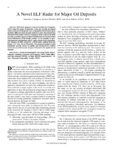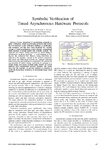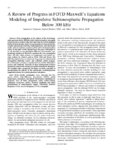1 - 25 of 20
| Creator | Title | Description | Subject | Date | ||
|---|---|---|---|---|---|---|
| 1 |
 |
Furse, Cynthia M. | Statistical comparison of capacity predictions for realistic MIMO channels | The impact of antenna polarization on channel capacity is explored in multiple-input, multiple-output (MIMO) systems. An idealized polarization model involving branch power rations (BPR's) and channel cross-coupling is incorporated into channel-specific capacity calculations. Results are compared f... | 2007-01-01 | |
| 2 |
 |
Tasdizen, Tolga | Automatic markup of neural cell membranes using boosted decision stumps | To better understand the central nervous system, neurobiologists need to reconstruct the underlying neural circuitry from electron microscopy images. One of the necessary tasks is to segment the individual neurons. For this purpose, we propose a supervised learning approach to detect the cell membra... | 2009 | |
| 3 |
 |
Furse, Cynthia M. | Making a world of difference recruitment of undergraduate students at USU | This paper describes two creative methods that are used to recruit undergraduate students at Utah State University. The fmt is "Engineering State", a four day hands-on immersement in a wide array of engineering disciplines, and the second is a slide show called "Making a World of Difference - Women ... | Student recruitment; Undergraduate recruitment; Engineering State | 1999 |
| 4 |
 |
Mathews, V. John | Vector quantization of images using visual masking functions | ABSTRACT This paper presents an image compression technique that incorporates visual masking functions in vector quantizer systems. Visual masking functions provide a description of the maximum amount of noise that can be present in an image, while remaining undetected when the image is viewed by ... | 1992 | |
| 5 |
 |
Mathews, V. John | Subband vector quantization of images using hexagonal filter banks | Abstract Results of psychophysical experiments on human vision conducted in the last three decades indicate that the eye performs a multichannel decomposition of the incident images. This paper presents a subband vector quantization algorithm that employs hexagonal filter banks. The hexagonal filte... | 1992 | |
| 6 |
 |
Harrison, Reid R. | Low-power FM transmitter for use in neural recording applications | We present a low power FM transmitter for use in neural recording telemetry. The transmitter consists of a low noise biopotential amplifier and a voltage controlled oscillator used to transmit the amplified neural signals at a frequency of 433 MHz. The circuit is powered through a transcutaneous,... | RF telemetry; Transmitter; Neural recording; Low power circuits; Multielectrode arrays; Voltage controlled oscillator (VCO) | 2004-01-01 |
| 7 |
 |
Tasdizen, Tolga; Whitaker, Ross T.; Jones, Bryan W. | Optimal-path approach for neural circuit reconstruction | Neurobiologists are collecting large amounts of electron microscopy image data to gain a better understanding of neuron organization in the central nervous system. Image analysis plays an important role in extracting the connectivity present in these images; however, due to the large size of these ... | 2008 | |
| 8 |
 |
Harrison, Reid R. | Micropower circuits for bidirectional wireless telemetry in neural recording applications | State-of-the art neural recording systems require electronics allowing for transcutaneous, bidirectional data transfer. As these circuits will be implanted near the brain, they must be small and low power. We have developed micropower integrated circuits for recovering clock and data signals over ... | Micropower circuits; Neural recording systems; Low-power CMOS circuits, RF telemetry; Transcutaneous data link; Transmitter | 2005-01-01 |
| 9 |
 |
Tasdizen, Tolga | Watershed merge forest classification for electron microscopy image stack segmentation | Automated electron microscopy (EM) image analysis techniques can be tremendously helpful for connectomics research. In this paper, we extend our previous work [1] and propose a fully automatic method to utilize inter-section information for intra-section neuron segmentation of EM image stacks. A wat... | 2013-01-01 | |
| 10 |
 |
Simpson, Jamesina J. | A novel ELF radar for major oil deposits | This letter proposes a novel extremely low frequency (ELF) radar for major oil deposits. Using our recently developed whole-Earth electromagnetic wave propagation model based upon the finite-difference time-domain method, we have determined that detection of the radial (vertical) component of the sc... | 2006-01-01 | |
| 11 |
 |
Stringfellow, Gerald B. | Radiative pair transitions in p-type ZnSe:Cu crystals | Shallow levels with an ionization energy of 0.012 eV play an important role in the photoelectronic properties of p-type ZnSe:Cu crystals. These levels exhibit the characteristics of the higher-lying member of an imperfection pair involved in luminescence emission, as well as of a trap determining lo... | Ionization energy; Luminescence emission; Crystals | 1968 |
| 12 |
 |
Tasdizen, Tolga | PIMs and invariant parts for shape recognition | We present completely new very powerful solutions t o two fundamental problems central to computer vision. 1. Given data sets representing C objects to be stored in a database, and given a new data set for an object, determine the object in the database that is most like the object measured. We so... | 1997 | |
| 13 |
 |
Stevens, Kenneth | Symbolic verification of timed asynchronous hardware protocols | Correct interaction of asynchronous protocols re- quires verification. Timed asynchronous protocols add another layer of complexity to the verification challenge. A methodology and automated tool flow have been developed for verifying systems of timed asynchronous circuits through compositional mode... | 2013-01-01 | |
| 14 |
 |
Simpson, Jamesina J. | FDTD modeling of a novel ELF radar for major oil deposits using a three-dimensional geodesic grid of the earth-ionosphere waveguide | This paper reports the first application of an optimized geodesic, three-dimensional (3-D) finite-difference time-domain (FDTD) grid to model impulsive, extremely low-frequency (ELF) electromagnetic wave propagation within the entire Earth-ionosphere cavity. This new model, which complements our pre... | 2006-01-01 | |
| 15 |
 |
Mathews, V. John | An optimal design procedure for intraband vector quantized subband coding | AbstTact- Subband coding with vector quantization is addressed in this paper. Forming the data vectors from both between and within the subbands is considered. The former of these two schemes is referred to as interband coding and the latter as intraband coding. Interband coder design is relatively ... | 1995 | |
| 16 |
 |
Stevens, Kenneth | Relative timing based verification of timed circuits and systems | Aggressive timed circuits, including synchronous and asynchronous self-resetting circuits, are particularly challenging to design and verify due to complicated timing constraints that must hold to ensure correct operation. Identifying a small, sufficient, and easily verifiable set of relative timin... | 2002 | |
| 17 |
 |
Simpson, Jamesina J. | A review of progress in FDTD Maxwell's equations modeling of impulsive subionospheric propagation below 300 kHz | Wave propagation at the bottom of the electromagnetic spectrum (below300 kHz) in the Earth-ionosphere waveguide system has been an interesting and important area of investigation for the last four decades. Such wave propagation is characterized by complex phenomena involving nonhomogeneous and aniso... | 2007-01-01 | |
| 18 |
 |
Stevens, Kenneth | Relative timing | Abstract-Relative timing (RT) is introduced as a method for asynchronous design. Timing requirements of a circuit are made explicit using relative timing. Timing can be directly added, removed, and optimized using this style. RT synthesis and verification are demonstrated on three example circuits,... | 2003 | |
| 19 |
 |
Myers, Chris J. | Learning genetic regulatory network connectivity from time series data | Abstract-Recent experimental advances facilitate the collection of time series data that indicate which genes in a cell are expressed. This information can be used to understand the genetic regulatory network that generates the data. Typically, Bayesian analysis approaches are applied which neglect ... | 2011 | |
| 20 |
 |
Stevens, Kenneth | Lazy transition systems and asynchronous circuit synthesis with relative timing assumptions | This paper presents a design flow for timed asynchronous circuits. It introduces lazy transitions systems as a new computational model to represent the timing information required for synthesis. The notion of laziness explicitly distinguishes between the enabling and the firing of an event in a tr... | 2002 |
1 - 25 of 20
